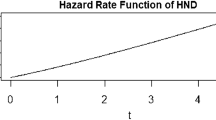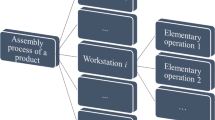Abstract
In recent years, advancement in technology brought a revolutionary change in the manufacturing processes. Therefore, manufacturing systems produce a large number of conforming items with a small amount of non-conforming items. The resulting dataset usually contains a large number of zeros with a small number of count observations. It is claimed that the excess number of zeros may cause over-dispersion in the data (i.e., when variance exceeds mean), which is not entirely correct. Actually, an excess amount of zeros reduce the mean of a dataset which causes inflation in the dispersion. Hence, modeling and monitoring of the products from high-yield processes have become a challenging task for quality inspectors. From these highly efficient processes, produced items are mostly zero-defect and modeled based on zero-inflated distributions like zero-inflated Poisson (ZIP) and zero-inflated Negative Binomial (ZINB) distributions. A control chart based on the ZIP distribution is used to monitor the zero-defect process. However, when additional over-dispersion exists in the zero-defect dataset, a control chart based on the ZINB distribution is a better alternative. Usually, it is difficult to ensure that data is over-dispersed or under-dispersed. Hence, a flexible distribution named zero-inflated Conway–Maxwell–Poisson (ZICOM-Poisson) distribution is used to model over or under-dispersed zero-defect dataset. In this study, CUSUM charts are designed based on the ZICOM-Poisson distribution. These provide a flexible monitoring method for quality practitioners. A simulation study is designed to access the performance of the proposed monitoring methods and their comparison. Moreover, a real application is presented to highlight the importance of the stated proposal.
Access this chapter
Tax calculation will be finalised at checkout
Purchases are for personal use only
Similar content being viewed by others
References
Abbas, N., Abujiya, M. R., Riaz, M., Mahmood, T., et al. (2020). Cumulative sum chart modeled under the presence of outliers. Mathematics, 8(2), 269.
Alevizakos, V., & Koukouvinos, C. (2019). A double exponentially weighted moving average control chart for monitoring com-poisson attributes. Quality and Reliability Engineering International, 35(7), 2130–2151.
Ali, S., Pievatolo, A., & Göb, R. (2016). An overview of control charts for high-quality processes. Quality and Reliability Engineering International, 32(7), 2171–2189.
Barriga, G. D., & Louzada, F. (2014). The zero-inflated conway-maxwell-poisson distribution: Bayesian inference, regression modeling and influence diagnostic. Statistical Methodology, 21, 23–34.
Bourke, P. D. (1991). Detecting a shift in fraction nonconforming using run-length control charts with 100% inspection. Journal of Quality Technology, 23(3), 225–238.
Chang, T., & Gan, F. (1999). Charting techniques for monitoring a random shock process. Quality and Reliability Engineering International, 15(4), 295–301.
Chou, Y. C., Chuang, H. H. C., & Shao, B. B. (2015). Information initiatives of mobile retailers: a regression analysis of zero-truncated count data with underdispersion. Applied Stochastic Models in Business and Industry, 31(4), 457–463.
Conway, R. W., & Maxwell, W. L. (1962). A queuing model with state dependent service rates. Journal of Industrial Engineering, 12(2), 132–136.
Faisal, M., Zafar, R. F., Abbas, N., Riaz, M., & Mahmood, T. (2018). A modified cusum control chart for monitoring industrial processes. Quality and Reliability Engineering International, 34(6), 1045–1058.
Gan, F. (1990). Monitoring observations generated from a binomial distribution using modified exponentially weighted moving average control chart. Journal of Statistical Computation and Simulation, 37(1–2), 45–60.
Gillispie, S. B., & Green, C. G. (2015). Approximating the conway-maxwell-poisson distribution normalization constant. Statistics, 49(5), 1062–1073.
He, S., Huang, W., & Woodall, W. H. (2012). Cusum charts for monitoring a zero-inflated poisson process. Quality and Reliability Engineering International, 28(2), 181–192.
He, S., Li, S., & He, Z. (2014). A combination of cusum charts for monitoring a zero-inflated poisson process. Communications in Statistics-Simulation and Computation, 43(10), 2482–2497.
Lambert, D. (1992). Zero-inflated poisson regression, with an application to defects in manufacturing. Technometrics, 34(1), 1–14.
Mahmood, T. (2020). Generalized linear model based monitoring methods for high-yield processes. Quality and Reliability Engineering International, 36(5), 1570–1591.
Mahmood, T., & **e, M. (2019). Models and monitoring of zero-inflated processes: The past and current trends. Quality and Reliability Engineering International, 35(8), 2540–2557.
Mahmood, T., Wittenberg, P., Zwetsloot, I. M., Wang, H., & Tsui, K. L. (2019). Monitoring data quality for telehealth systems in the presence of missing data. International Journal of Medical Informatics, 126, 156–163.
McCullagh, P., & Nelder, J. (1983). Generalized linear models. London: Chapman and Hall.
Montgomery, D. C. (2009). Statistical quality control (Vol. 7). New York: Wiley.
Page, E. S. (1954). Continuous inspection schemes. Biometrika, 41(1/2), 100–115.
Riaz, M., Abbas, N., & Mahmood, T. (2017). A communicative property with its industrial applications. Quality and Reliability Engineering International, 33(8), 2761–2763.
Roberts, S. (1959). Control chart tests based on geometric moving averages. Technometrics, 1(3), 239–250.
Saghir, A., & Lin, Z. (2014a). Control chart for monitoring multivariate com-poisson attributes. Journal of Applied Statistics, 41(1), 200–214.
Saghir, A., & Lin, Z. (2014b). Cumulative sum charts for monitoring the com-poisson processes. Computers and Industrial Engineering, 68, 65–77.
Saghir, A., & Lin, Z. (2014c). A flexible and generalized exponentially weighted moving average control chart for count data. Quality and Reliability Engineering International, 30(8), 1427–1443.
Saghir, A., & Lin, Z. (2015). Control charts for dispersed count data: an overview. Quality and Reliability Engineering International, 31(5), 725–739.
Saghir, A., Lin, Z., Abbasi, S. A., & Ahmad, S. (2013). The use of probability limits of com-poisson charts and their applications. Quality and Reliability Engineering International, 29(5), 759–770.
Sellers, K., Lotze, T., & Raim, A. (2017). Compoissonreg: Conway-maxwell poisson (com-poisson) regression. https://CRAN.R-project.org/package=COMPoissonRegRpackage version 04 1:380
Sellers, K. F. (2012). A generalized statistical control chart for over-or under-dispersed data. Quality and Reliability Engineering International, 28(1), 59–65.
Sellers, K. F., & Raim, A. (2016). A flexible zero-inflated model to address data dispersion. Computational Statistics and Data Analysis, 99, 68–80.
Shewhart, W. A. (1926). Quality control charts. The Bell System Technical Journal, 5(4), 593–603.
Shmueli, G., Minka, T. P., Kadane, J. B., Borle, S., & Boatwright, P. (2005). A useful distribution for fitting discrete data: revival of the conway-maxwell-poisson distribution. Journal of the Royal Statistical Society: Series C (Applied Statistics), 54(1), 127–142.
Sim, S. Z., Gupta, R. C., & Ong, S. H. (2018). Zero-inflated conway-maxwell poisson distribution to analyze discrete data. The International Journal of Biostatistics, 14(1), 20160,070.
**e, M., & Goh, T. (1993). Spc of a near zero-defect process subject to random shocks. Quality and Reliability Engineering International, 9(2), 89–93.
**e, M., Goh, T., & Kuralmani, V. (2000). On optimal setting of control limits for geometric chart. International Journal of Reliability, Quality and Safety Engineering, 7(1), 17–25.
**e, W., **e, M., & Goh, T. (1995). Control charts for processes subject to random shocks. Quality and Reliability Engineering International, 11(5), 355–360.
Author information
Authors and Affiliations
Corresponding author
Editor information
Editors and Affiliations
Rights and permissions
Copyright information
© 2021 Springer Nature Switzerland AG
About this paper
Cite this paper
Mahmood, T., Sanusi, R.A., **e, M. (2021). Flexible Monitoring Methods for High-yield Processes. In: Knoth, S., Schmid, W. (eds) Frontiers in Statistical Quality Control 13. ISQC 2019. Frontiers in Statistical Quality Control. Springer, Cham. https://doi.org/10.1007/978-3-030-67856-2_4
Download citation
DOI: https://doi.org/10.1007/978-3-030-67856-2_4
Published:
Publisher Name: Springer, Cham
Print ISBN: 978-3-030-67855-5
Online ISBN: 978-3-030-67856-2
eBook Packages: Mathematics and StatisticsMathematics and Statistics (R0)




